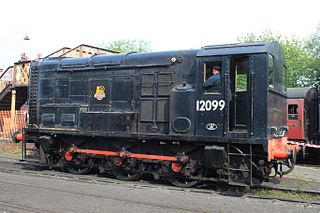
A switcher or shunter is a small railroad locomotive intended not for moving trains over long distances but rather for assembling trains ready for a road locomotive to take over, disassembling a train that has been brought in, and generally moving railroad cars around – a process usually known as switching (USA) or shunting (UK). They do this in classification yards. Switchers may also make short transfer runs and even be the only motive power on branch lines and switching and terminal railroads. The term can also be used to describe the workers operating these engines or engaged in directing shunting operations.
The London, Midland and Scottish Railway had the largest stock of steam locomotives of any of the 'Big Four' Grouping, i.e. pre-Nationalisation railway companies in the UK. Despite early troubles arising from factions within the new company, the LMS went on to build some very successful designs; many lasted until the end of steam traction on British Railways in 1968. For an explanation of numbering and classification, see British Rail locomotive and multiple unit numbering and classification.

The British Rail Class 05 is a class of 0-6-0 diesel-mechanical shunters built by Hunslet Engine Company from 1955 to 1961. They were used on the Eastern and Scottish Regions of British Railways. The first two batches were delivered as 11136-11143 and 11161-11176 Subsequent locos were delivered as D2574-D2618

The British Rail (BR) Class 08 is a class of diesel-electric shunting locomotive. The pioneer locomotive, number 13000, was built in 1952 although it did not enter service until 1953. Production continued until 1962; 996 locomotives were produced, making it the most numerous of all British locomotive classes.

The British Rail Class 11 was applied to a batch of diesel shunting locomotives built from April 1945 to December 1952, based on a similar earlier batch built by the London, Midland and Scottish Railway (LMS) between 1934 and 1936.

The British Railways Class D3/7 were a class of 0-6-0 diesel electric shunting locomotives built as LMS Nos. 7080–7119. The class were built from May 1939 through to July 1942 by the London, Midland and Scottish Railway at their Derby Works using a diesel electric transmission supplied by English Electric.
The London, Midland and Scottish Railway (LMS) pioneered the use of diesel shunting locomotives in Great Britain. The variety of experimental and production diesel shunters produced by the LMS is summarised below. In each heading, the first number(s) carried are shown first, with subsequent renumbering(s) following the "/".
The Great Western Railway purchased two diesel shunters, and ordered a further seven immediately prior to Nationalisation, which were delivered to British Rail in 1948-49. The two shunters used by the GWR were numbered 1 and 2, while a series commencing at 501 was planned for the new locomotives ordered in the 1940s. British Rail numbered 2 and the new locomotives in a series commencing at 15100.

The London Midland and Scottish Railway (LMS) Fowler 3F 0-6-0T is a class of steam locomotive, often known as Jinty. They represent the ultimate development of the Midland Railway's six-coupled tank engines.

LMS diesel shunter 7050 is an experimental 0-4-0 diesel-mechanical shunting locomotive, introduced by the London Midland and Scottish Railway (LMSR) in 1934 and which remained in service with that railway for six years. It was later acquired for military use and is now preserved at the National Railway Museum.

W. G. Bagnall was a locomotive manufacturer from Stafford, England which was founded in 1875 and operated until it was taken over in 1962 by English Electric.
London Midland and Scottish Railway diesel locomotive 7051 was built by the Hunslet Engine Company to demonstrate its wares. After public exhibition in February 1932, it was used for trials at a colliery, before being tested by the LMS. After further public exhibition in February 1933, it was at last purchased by the LMS in May 1933. It was loaned to the War Department from August 1940, which numbered it 27. During 1941–1944 it was returned to the LMS, but in August 1944 it returned to the WD, now numbered 70027. After the end of World War 2 it was returned to the LMS, but was withdrawn in December 1945 and resold back to Hunslet. Hunslet used the locomotive as a works shunter, but it was also available for hire, and spent time at oil refineries in Essex and with British Railways.
LMS diesel shunter 7052 was an experimental 0-6-0 diesel-mechanical shunting locomotive, introduced by the London Midland and Scottish Railway (LMSR) in 1934 and which remained in service with that railway for six years. It was later acquired for military use until 1966.
LMS diesel shunter 7053 carried its original number of 7403 only within the Hunslet Engine Company's works, and was delivered as LMS number 7053. It was of almost exactly the same size and shape as LMS diesel shunter 7052, but had different internal fittings. It was loaned to the War Department between 1939-1942, which numbered it 23. Immediately upon return to the LMS, in December 1942, it was withdrawn from stock and sold back to Hunslet. No further use was found for it and it was eventually dismantled during the mid-1950s.
LMS diesel shunters 7055/6 were built by Hudswell Clarke. They were initially allocated numbers 7405/7406 but these numbers were never carried. Testing started in August 1934. One locomotive was taken into LMS stock in December 1934 and the other in October 1935.
LMS diesel shunter 7057, later to become NCC Class 22, was built by Harland & Wolff. Testing started in July 1934 and the locomotive was taken into LMS stock in February 1935. It was loaned to the War Department between 1941-1943, which numbered it 233. It was withdrawn from LMS stock in January 1944 and sold back to Harland & Wolff, which rebuilt it with a new 225 hp (168 kW) engine and converted it to the 5 ft 3 in gauge. It was then sold to the Northern Counties Committee, which numbered it 22. It was finally withdrawn in April 1965 and scrapped at the close of that year.
LMS diesel shunter 7058 was based on an earlier Armstrong Whitworth prototype of 1932, which had been tested by the London, Midland and Scottish Railway. It was initially numbered 7408 and then re-numbered 7058.
The War Department ex-LMS Fowler Class 3F consisted of 8 LMS Fowler Class 3F 0-6-0T steam locomotives requisitioned in 1940 from the London Midland and Scottish Railway (LMS).
LMS diesel shunters 7059–7068 were 0-6-0 diesel-electric shunters built by Armstrong Whitworth in 1936. Maker's numbers D54-D63. The diesel engine was an Armstrong-Sulzer 6LTD22 of 350 bhp at 875 rpm. There was a single Crompton Parkinson traction motor with a rating of 231 hp (continuous) or 358 hp. Final drive was by double reduction gears of 11.1:1 ratio and jackshafts. These locomotives were similar in appearance to LMS 7080–7119 although the internal equipment was different. They started work in 1936 and were allocated to Crewe South (7059–7063) and Kingmoor (7064–7068).












